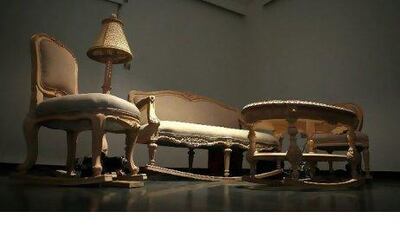Without Hope Without Fear
Away from the main gallery drag, and with a frontage that blends into the industrial patina of Al Quoz, Mottahedan Projects is certainly discreet. It opened during Art Dubai without the near-mandatory lavish launch or barrage of press releases.
So, it's amid this air of discretion that we check out the gallery's Dubai debut - Without Hope Without Fear,an exhibition title that riffs on the 16th-century painter Caravaggio's savant motto for his roller-coaster life.
"Artists who do unconventional things are the ones that make it," says Matt Mottahedan, the director and curator of the new space and anactive collector in London. "To be unconventional in your work demands that you have no fear."
With that in mind, Mottahedan has assembled a handful of artworks by Western and Middle Eastern artists who, he feels, are striking out for this hinterland. And there's some decent work on show here.
Take Tala Madani, a US-based Iranian artist, who uses stop-motion animation to bring to life the balding men she paints on canvas. In each of the video works, created last year, the clownish exploits of her men beginwith a cartoon-like absurdity - hurling hammers at each other, pushing each other in front of trains - only to climax in a discordant note of graphic violence.
Likewise, Reza Aramesh's sculpture, Action 125, is a visceral if familiar addition (with works in a similar series exhibited last year in Dubai). It is a wooden sculpture of a man in beat-up blue jeans lying on the floor with his hands behind his back. His eyes glisten at us with polychrome paint.
The Iranian artist is known for black-and-white images that depict non-professional actors "restaging" scenes from war photography and reportage. By extension, Aramesh has used all the visual motifs of European religious sculptures from its golden age in the 18th century (working with an atelier in the Italian Alps, one of the remaining few that specialises in this polychrome style of sculpture) to recreate a scene from Abu Ghraib prison in Iraq. The work carries ideas about martyrdom and the media.
Then there are the western artists: an amazing work by Matthew Monahan stands out. The American artist creates sculptures out of the most banal materials such as packing foam and fibreglass. The figure encased in this vice-like time capsule of detritus looks like remains that archaeologists might dig up in 300 years and say: "Ah, he was of the 21st century".
There are also a couple of pieces by Carroll Dunham from the 1990s that, despite the sweating colours of The Second Green Planet (a sort of snotty global apocalypse), show a relatively less abrasive side of the artist compared to his recent work. Look out as well for the collages by Lara Schnitger.
A lot of these pieces come from Mottahedan's personal collection, and he explains that the exhibition is about showing that engagement and interests can be global and need not be restricted by geography. While this isn't the most original of ideas, it's still good to see some of these pieces rolled out in Dubai.
But the problem lies in this opening show's discreetness. There are no labels and no catalogues. The exhibit space feels a little like an airy showroom as a result; totally at odds with the high-minded ideas that its curator posits. Passing traffic, I suspect, will leave curious but bewildered by what they've just seen.
It's still in its early days, and the gallerist insists that after summer the space will launch with appropriate pomp. Judging by what we've seen, there's more hope than fear at this stage.
• Mottahedan Projects, Al Quoz, Dubai, until June 21
Deer in the Headlights
A living room in which the furniture eerily rocks, a row of miniature Louis XVI chairs warped and dismembered, and a performance piece on opening night in which a model brandishing a lampshade on her head disturbed Abu Dhabi's assembled gallery goers - Shamsa Al Omaira's first solo show, Deer in the Headlights, sets a tone of unsettling domesticity. "These pieces speak about what happens when we restrain our personality," she says. "That's the struggle that we as human beings have. It's very frustrating."
Al Omaira's work is currently at Ghaf Art Gallery, ahead of her graduation from Zayed University's Visual Arts programme this summer. There's a stridently conceptual slant to what she's showing, but it also isn't simply a jumble of found objects and attached significance. The artist has designed these ominously swinging rocking chairs (powered by an off-puttingly obvious battery) and she designed the dress that the model was wearing at the impromptu opening night performance. Everything has been altered and shaped, and several of these pieces are driven with smart, developed ideas.
"I love the history of objects," she says. "The chairs that I work with all have a certain history to them, a lot based on French antiques and quite rare to find in shops."
Al Omaira explains that each piece of furniture (from the doll's house variety that she's tortured and attached like trophies to the wall, through to the eerie rockers) is a personification of individual histories as they are shaped by external factors.
Of the opening night performance she says: "A lampshade is used to diffuse the light - it's a metaphor about being concealing or diffusing your personality. I'm from a society where everyone knows everyone. Sometimes I want to be that person."
Keep an eye out for the paintings on stretched fabric - again, more chairs. But they offset the installation works to create a coherence and togetherness in the exhibition that looks promising.
Ghaf Art Gallery, Al Khaleej Al Arabi Street, Abu Dhabi until Thursday
1. Mottahedan Projects, Al Joud Centre, Sheikh Zayed Road, Dubai 04 380 5525, rene@mottahedan.com, www.mottahedan.com, Saturday to Thursday, 11am-3pm
2. Ghaf Art Gallery, Al Khaleej Al Arabi Street, Abu Dhabi, 02 665 5332, ghafgallery@gmail.com, www.ghafgallery.blogspot.com, Saturday to Thursday, 10am-9pm

